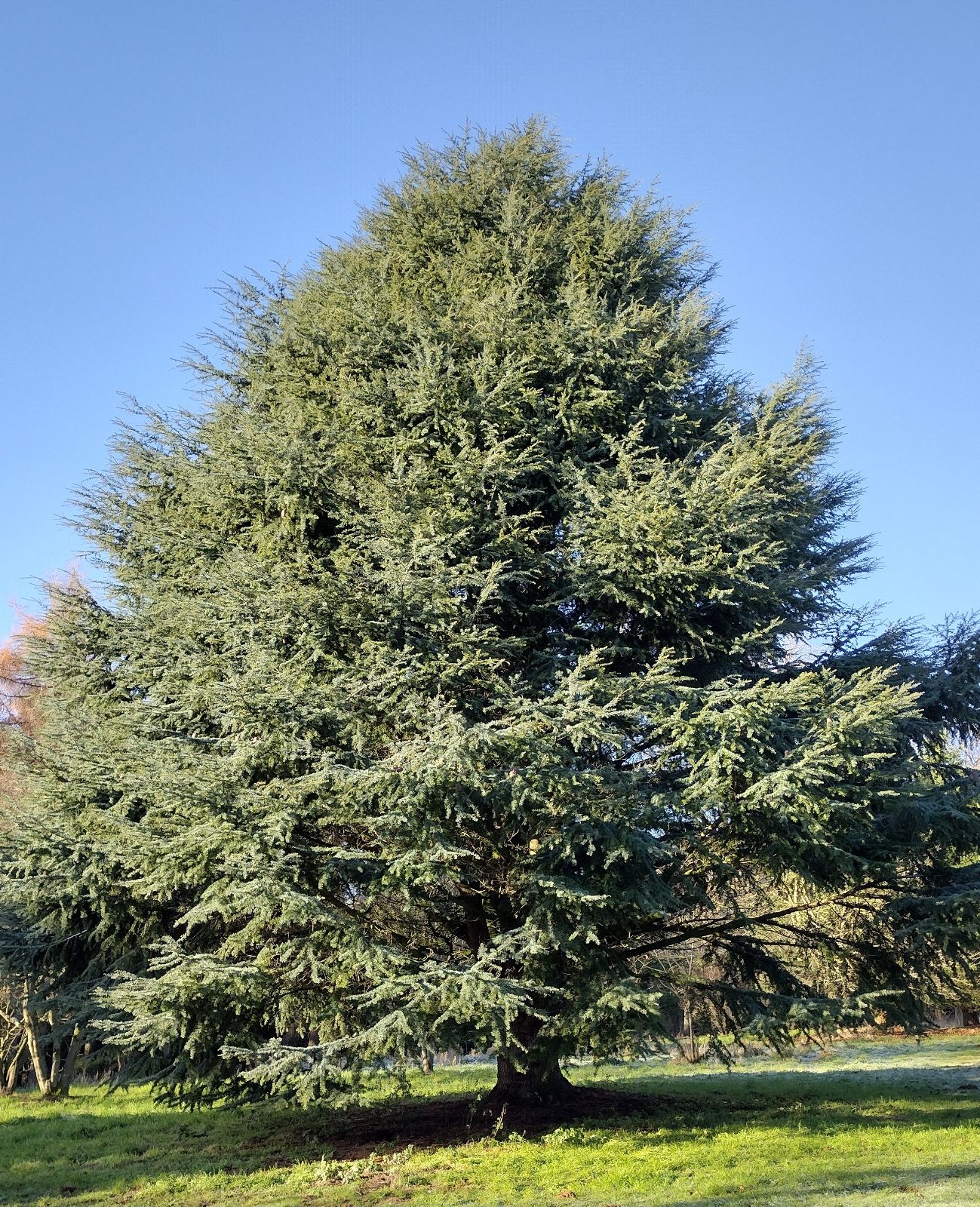Cedrus Tesi Group
Sponsor
Kindly sponsored by
a member of the International Dendrology Society
Credits
Tom Christian (2021)
Recommended citation
Christian, T. (2021), 'Cedrus Tesi Group' from the website Trees and Shrubs Online (treesandshrubsonline.
Genus
- Cedrus
- C. atlantica × C. deodara
Synonyms
- Cedrus × tesi
Infraspecifics
Other taxa in genus
Hybrids between any form of Cedrus deodara and C. atlantica. Trees appear intermediate between their parents but may be distinguished from both in the following ways: habit (wider spreading than C. deodara, broad-pyramidal in outline); first order branches ascending (at least in young trees) and gradually nodding at the tips (neither level nor ascending as in C. atlantica, nor abruptly nodding or pendulous as in C. deodara). The foliage is variably glaucescent, but the combination of long needles (a proportion >3 cm long), wide-spreading branches with gradually nodding tips, and a pyramidal outline, are distinctive in combination. (Christian 2021).
When this account of the genus Cedrus was prepared for Trees and Shrubs Online in 2019–2020, hybrids between Atlas and Deodar Cedars were represented in literature and horticulture by a multitude of names. They would sometimes be referred to a nothospecies, C. × tesi, which is the name attached to one plant at the Yorkshire Arboretum, obtained in 1984 from the Zu Jeddeloh nursery in Germany (J. Grimshaw, pers. comm. 2020). However, there is no evidence that this name was ever validly published, and none of the other names in common useage accurately reflected the parentage of these hybrids – the only cultivar known with certainty to belong here is usually listed under C. deodara. In the revision of this genus for Trees and Shrubs Online such hybrids were referred to under ‘Cedrus atlantica × deodara’.
In order to provide a nomenclatural home for plants referable to this cross the name Cedrus Tesi Group was published by the present author in 2021, the Group name honouring the Italian horticultural dynasty who have raised many such hybrids (Christian 2021). This name covers any cross between Atlas and Deodar Cedars, regardless of the circumstances in which the cross is made and of the taxonomic rank and position afforded to Atlas Cedar. Only one cultivar, ‘Ibrido’ is known with certainty to belong here – it is discussed below.
Besides the hybrids raised in the Tesi nurseries in northern Italy, this cross has also been made deliberately in France, and is known to occur sporadically wherever the parents are grown together in warm climates, for example in South Africa and in parts of South America (Knap 2003).
'Ibrido'
Common Names
Hybrid Cedar
Synonyms / alternative names
Cedrus deodara 'Ibrido'
Cedrus deodara 'Ibridio'
Cedrus deodara 'Ibridio Tesi'
Cedrus × 'Ibridio Tesi'
Cedrus 'Tesi'
A quick glance at the reference books for information on C. deodara ‘Ibrido’ (as it is often sold) offers a deceptively simple overview: A likely hybrid between C. deodara and C. atlantica Glauca Group, making a tree of open, pyramidal habit. The branches somewhat ascendent, the foliage blue-green (Auders & Spicer 2012; Hatch 2018–2020).
Hybrid Cedars have been known for some time, and the name Cedrus × tesi, referring to a cross between Deodar and (any form of) Atlas Cedar, is applied to some plants in living collections, for example one very handsome tree at the Yorkshire Arboretum, UK, obtained in 1984 from the Zu Jeddeloh nursery in Germany (J. Grimshaw, pers. comm. 2020). Unfortunately it does not appear that this name was ever validly published, but a transcript of a talk on Deodars posted on the webpage of the Czech Dendrology Society offers some curious insights (Knap 2003). Knap reports that a Mr Tesi, an Italian nurseryman, made the cross at his family’s nurseries in northern Italy, developing them until they were released into commerce. Knap adds ‘Since this crossing is also spontaneous and is therefore easy, Mr. Tesi managed to get many F1 hybrids…It was named after [the nurseryman Mr. Tesi] Cedrus × ‘Ibridio Tesi’, sometimes also Cedrus deodara ‘Ibridio’ or even Cedrus deodara ‘Ibridio Tesi” (Knap 2003).
In this surfeit of names lurks further confusion. The hybrid names above all include the word ‘ibridio’ and the same spelling is regularly encountered for example in Hatch (2018–2020) and in Auders & Spicer (2012), with Knap (2003) himself explaining that this means ‘hybrid’ in Italian. The problem is it does not. The Italian for hybrid is ‘ibrido’, not ‘ibridio’. The plural in Italian is ‘ibridi’ but there is no letter ‘o’ on the end. This begs the question of what was actually intended with regard to the name – ‘Ibridi Tesi’, the Tesi hybrids, perhaps? – but this is impossible to answer here at the present time. There was clearly a need for a valid nomenclatural ‘home’ for any such hybrid, but given the controversy regarding the taxonomic position of Atlas Cedar it was felt better to publish a Group name, adopted here, rather than a formal nothospecies.

